Empezamos por el de Alcobaça, fundado en 1153 por el Rey Dom Alfonso Henrique para conmemorar la victoria sobre los Moros en Santarém, seis años antes. Además de por su arquitectura, es conocido por una historia trágica y romántica, ya que están allí las tumbas de Dom Pedro y Dona Inês de Castro (más sobre esto más adelante).
On our fifth day we travelled some 100 km North of Mafra to visit two famous monasteries, Alcobaça and Batalha, both among the best examples of Portuguese Gothic architecture.
We started with the Monastery of Alcobaça, founded in 1153 by the King Dom Alfonso Henrique, to commemorate the victory over the Moors at Santarém, six years before. In addition to its architecture, it's famous for a tragic and romantic story, since it houses the tombs of Dom Pedro and Dona Inês de Castro (more on this below).
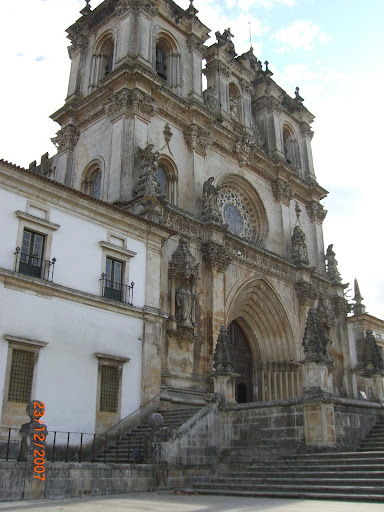
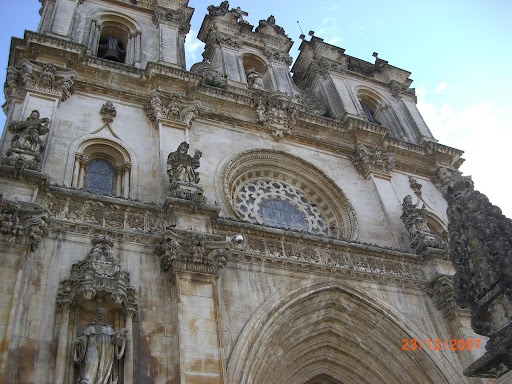
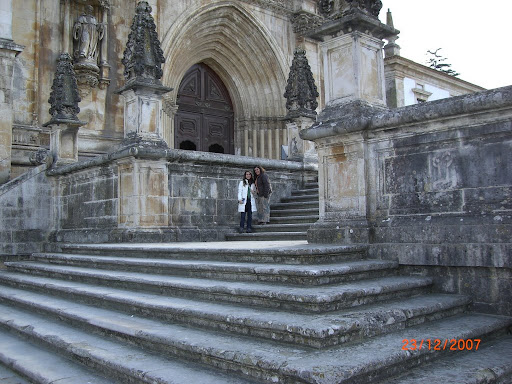
La fachada. Estuvimos un buen rato admirándola.
The façade. We spent a good while admiring it.

La Sala dos Reis (Sala de los Reyes), con azulejos azules del siglo XVIII representando la batalla de Santarém y arriba, todo alrededor de la sala, estatuas de los reyes de Portugal. A la derecha abajo se ve una olla enorme que fue capturada en la batalla de Aljubarrota, en 1385. Pertenecía al ejército español, que fue derrotado en esa batalla.
The Sala dos Reis (Hall of Kings), with blue 18th century tiles depicting the battle of Santarém and high up, all around the hall, statues of the kings of Portugal. On the bottom right-hand corner you can see a huge cauldron captured during the battle of Aljubarrota, in 1385. It belonged to the Spanish army, which was defeated in that battle.
Paseando por los claustros del monasterio. Actualmente está vacío, ya que fue disuelto en el siglo XIX.
Taking a walk around the monastery's cloisters. It's currently empty, having been dissolved in the 19th century.

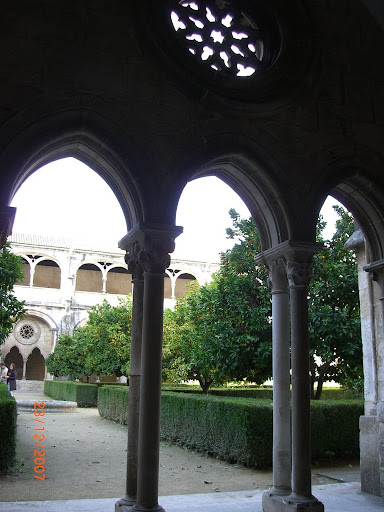

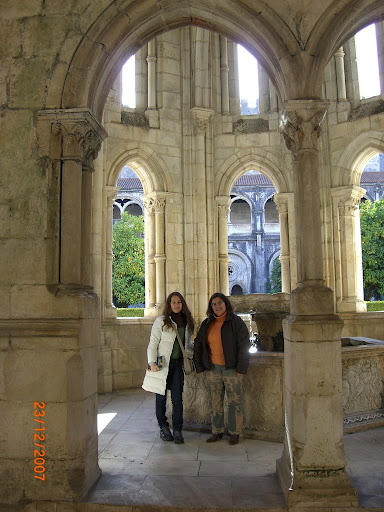

Salas donde vivían los monjes. Los de Alcobaça eran conocidos por el lujo en que vivían y comían.
Rooms in which the monks lived. Those of Alcobaça were well known for the luxury in which they lived and ate.
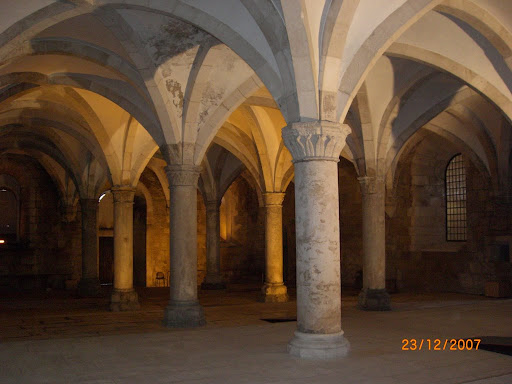



La iglesia. Esta sí está todavía en uso.
The church. This one is still in use.
Es en la iglesia que están las tumbas de Dom Pedro y Dona Inês. La historia, muy resumida, es la siguiente, y tuvo lugar a mediados del siglo XIV: Pedro era el hijo del Rey Alfonso IV, y heredero del trono. Estaba casado con Constanza de Castilla, pero se enamoró de una de sus damas de compañía, Inês de Castro. Inês venía de una familia gallega muy poderosa, y eso hacía que el Rey temiera que fueran a ser una fuerte influencia española sobre el trono portugués. Por esta razón, cuando Constanza murió, le prohibió a su hijo que se casaran y exilió a Inês de la corte.
Pedro fue atrás de ella y durante los 10 años siguientes él e Inês vivieron juntos y hasta tuvieron hijos. Pero llegó un momento que el Rey, viendo como su hijo favorecía a la familia de Inês y a otros nobles españoles, se vio persuadido por sus propios nobles a aprobar que la asesinaran. La muerte de Inês provocó una rebelión de Pedro contra su padre y una guerra civil, que terminó con Pedro asumiendo la corona en un par de años, a la muerte de Alfonso.
Sus primeras acciones fueron vengar la muerte de su amada, y se dice que incluso arrancó en corazón de sus asesinos con sus propias manos. Pero la parte más trágica y macabra de la historia es la leyenda que dice que, afirmando que él e Inês se habían casado en secreto, la desenterró y coronó su cadaver, forzando a todos los miembros de la corte, que habían desaprobado de ella, a besar su mano en descomposición.
*-*-*-*-*
It's in the church that we find the tombs of Dom Pedro and Dona Inês. The story is the following, and it took place in the mid 14th century: Pedro was the son of King Alfonso IV and heir to the throne. He was married to Constance of Castille, but he fell in love with one of her maids, Inês de Castro. Inês was from a powerful Galician family, and this made the King fear they could be a strong Spanish influence over the Portuguese throne. Because of this, when Constance died, he forbid his son to marry her and exiled Inês from the Court.
Pedro followed her, and during the next 10 or so years he and Inês lived together and even had children. But there came a time when the King, seeing how his son favoured Inês' family and other Spanish nobles, was persuaded by his own nobles to sanction her murder. Inês' death sparked Pedro's rebellion against his father and a civil war, which ended with Pedro succeeding to the throne a couple of years later, on his father's death.
His first actions were to avenge his beloved's death, and it's said he actually tore the murderers' hearts out with his own hands. But the most tragic and macabre part of the story is the legend that holds that, claiming he and Inês had secretly married, he exhumed and crowned her corpse, forcing all the courtiers, who'd disapproved of her, to kiss her decomposing hand.
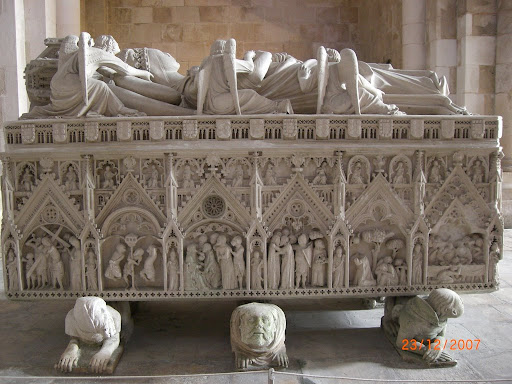
Esta es la tumba de Inês, espectacularmente decorada.
This is Inês' tomb, spectacularly decorated.
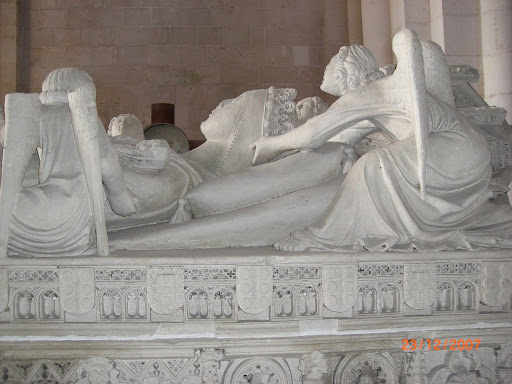
Más de cerca. Vean a los ángeles instándola a levantarse.
Close-up. See the angels urging her to rise.
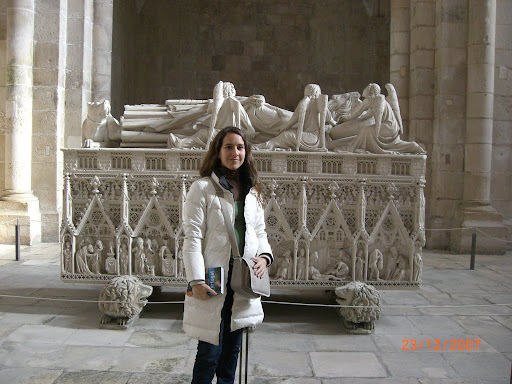
Y esta es la de Pedro, también siendo urgido a levantarse por los ángeles.
And this is that of Pedro's, also being encouraged to rise by the angels.
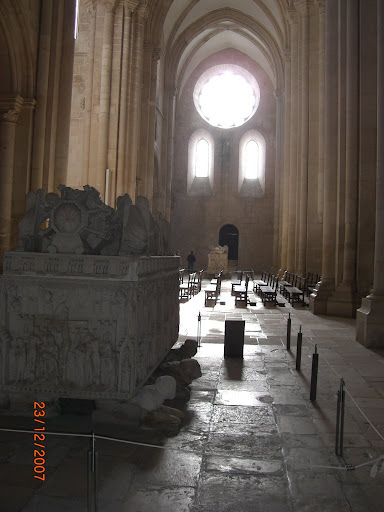
Así están ubicadas las tumbas, una frente a la otra, con la nave en el medio. Están pie contra pie, de forma de que cuando los cuerpos se levanten en el día del Juicio Final, lo primero que vean Pedro e Inês sea el uno al otro.
Here's how the tumbs are placed, one across the nave from the other. They're foot to foot, so that, when the bodies rise up on Judgment Day, the first thing Inês and Pedro will see will be each other.

